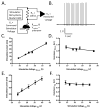Development and pharmacologic characterization of the rat 6 Hz model of partial seizures
- PMID: 28449218
- PMCID: PMC5469205
- DOI: 10.1111/epi.13764
Development and pharmacologic characterization of the rat 6 Hz model of partial seizures
Abstract
Objective: The mouse 6 Hz model of psychomotor seizures is a well-established and commonly used preclinical model for antiseizure drug (ASD) discovery. Despite its widespread use both in the identification and differentiation of novel ASDs in mice, a corresponding assay in rats has not been developed. We established a method for 6 Hz seizure induction in rats, with seizure behaviors similar to those observed in mice including head nod, jaw clonus, and forelimb clonus.
Methods: A convulsive current that elicits these seizure behaviors in 97% of rats (CC97 ) was determined using a Probit analysis. Numerous prototype ASDs were evaluated in this model using stimulus intensities of 1.5× and 2× the CC97 , which is comparable to the approach used in the mouse 6 Hz seizure model (e.g., 32 and 44 mA stimulus intensities). The ASDs evaluated include carbamazepine, clobazam, clonazepam, eslicarbazepine, ethosuximide, ezogabine, gabapentin, lacosamide, lamotrigine, levetiracetam, phenobarbital, phenytoin, rufinamide, tiagabine, topiramate, and sodium valproate. Median effective dose (ED50 ) and median toxic (motor impairment) dose (TD50 ) values were obtained for each compound.
Results: Compounds that were effective at the 1.5 × CC97 stimulus intensity at protective index (PI) values >1 included clobazam, ethosuximide, ezogabine, levetiracetam, phenobarbital, and sodium valproate. Compounds that were effective at the 2 × CC97 stimulus intensity at PI values >1 included ezogabine, phenobarbital, and sodium valproate.
Significance: In a manner similar to the use of the mouse 6 Hz model, development of a rat 6 Hz test will aid in the differentiation of ASDs, as well as in study design and dose selection for chronic rat models of pharmacoresistant epilepsy. The limited number of established ASDs with demonstrable efficacy at the higher stimulus intensity suggests that, like the mouse 6 Hz 44 mA model, the rat 6 Hz seizure model may be a useful screening tool for pharmacoresistant seizures.
Keywords: Animal models; Antiseizure drugs; Pharmacoresistant seizures; Psychomotor seizures.
Wiley Periodicals, Inc. © 2017 International League Against Epilepsy.
Conflict of interest statement
None of the authors has any conflict of interest to disclose. We confirm that we have read the Journal’s position on issues involved in ethical publication and affirm that this report is consistent with those guidelines.
Figures


Similar articles
-
Pharmacological characterization of the 6 Hz psychomotor seizure model of partial epilepsy.Epilepsy Res. 2001 Dec;47(3):217-27. doi: 10.1016/s0920-1211(01)00302-3. Epilepsy Res. 2001. PMID: 11738929
-
Antiseizure drug efficacy and tolerability in established and novel drug discovery seizure models in outbred vs inbred mice.Epilepsia. 2020 Sep;61(9):2022-2034. doi: 10.1111/epi.16624. Epub 2020 Aug 5. Epilepsia. 2020. PMID: 32757210 Free PMC article.
-
Recurrent epileptiform discharges in the medial entorhinal cortex of kainate-treated rats are differentially sensitive to antiseizure drugs.Epilepsia. 2018 Nov;59(11):2035-2048. doi: 10.1111/epi.14563. Epub 2018 Oct 17. Epilepsia. 2018. PMID: 30328622 Free PMC article.
-
The Search for New Screening Models of Pharmacoresistant Epilepsy: Is Induction of Acute Seizures in Epileptic Rodents a Suitable Approach?Neurochem Res. 2017 Jul;42(7):1926-1938. doi: 10.1007/s11064-016-2025-7. Epub 2016 Aug 8. Neurochem Res. 2017. PMID: 27502939 Review.
-
Animal Models of Seizures and Epilepsy: Past, Present, and Future Role for the Discovery of Antiseizure Drugs.Neurochem Res. 2017 Jul;42(7):1873-1888. doi: 10.1007/s11064-017-2222-z. Epub 2017 Mar 13. Neurochem Res. 2017. PMID: 28290134 Review.
Cited by
-
Modelling and treating GRIN2A developmental and epileptic encephalopathy in mice.Brain. 2020 Jul 1;143(7):2039-2057. doi: 10.1093/brain/awaa147. Brain. 2020. PMID: 32577763 Free PMC article.
-
Reductions in Hydrogen Sulfide and Changes in Mitochondrial Quality Control Proteins Are Evident in the Early Phases of the Corneally Kindled Mouse Model of Epilepsy.Int J Mol Sci. 2022 Jan 27;23(3):1434. doi: 10.3390/ijms23031434. Int J Mol Sci. 2022. PMID: 35163358 Free PMC article.
-
A companion to the preclinical common data elements for pharmacologic studies in animal models of seizures and epilepsy. A Report of the TASK3 Pharmacology Working Group of the ILAE/AES Joint Translational Task Force.Epilepsia Open. 2018 Sep 15;3(Suppl Suppl 1):53-68. doi: 10.1002/epi4.12254. eCollection 2018 Nov. Epilepsia Open. 2018. PMID: 30450485 Free PMC article.
-
Identification of New Compounds with Anticonvulsant and Antinociceptive Properties in a Group of 3-substituted (2,5-dioxo-pyrrolidin-1-yl)(phenyl)-Acetamides.Int J Mol Sci. 2021 Dec 3;22(23):13092. doi: 10.3390/ijms222313092. Int J Mol Sci. 2021. PMID: 34884898 Free PMC article.
-
1,2,4-Triazole-based anticonvulsant agents with additional ROS scavenging activity are effective in a model of pharmacoresistant epilepsy.J Enzyme Inhib Med Chem. 2020 Dec;35(1):993-1002. doi: 10.1080/14756366.2020.1748026. J Enzyme Inhib Med Chem. 2020. PMID: 32253957 Free PMC article.
References
-
- Toman JE. Neuropharmacologic considerations in psychic seizures. Neurology. 1951;1:444–460. - PubMed
-
- Brown WC, Schiffman DO, Swinyard EA, et al. Comparative assay of an antiepileptic drugs by psychomotor seizure test and minimal electroshock threshold test. J Pharmacol Exp Ther. 1953;107:273–283. - PubMed
-
- Barton ME, Klein BD, Wolf HH, et al. Pharmacological characterization of the 6 Hz psychomotor seizure model of partial epilepsy. Epilepsy Res. 2001;47:217–227. - PubMed
-
- Barton ME, Peters SC, Shannon HE. Comparison of the effect of glutamate receptor modulators in the 6 Hz and maximal electroshock seizure models. Epilepsy Res. 2003;56:17–26. - PubMed
-
- Bialer M, Johannessen SI, Levy RH, et al. Progress report on new antiepileptic drugs: a summary of the Eleventh Eilat Conference (EILAT XI) Epilepsy Res. 2013;103:2–30. - PubMed
Publication types
MeSH terms
Substances
Grants and funding
LinkOut - more resources
Full Text Sources
Other Literature Sources
Research Materials
Miscellaneous

